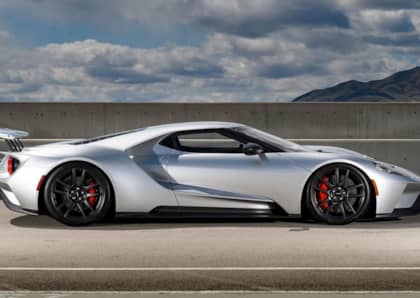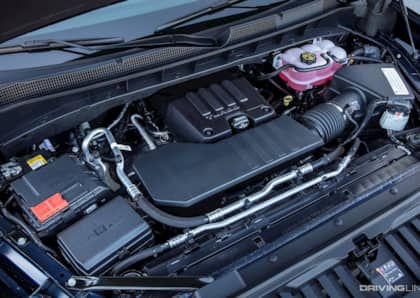EcoBoosted: Why Ford’s Small Cube, Forced Induction Mills Are So Popular
Banking on a V6 being the preferred engine to power the F-150 was a bold move on Ford’s part. But then again, it wasn’t just any V6. The EcoBoost 3.5L featured twin-turbochargers, direct injection, and 10:1 compression when it debuted on the ’11 F-150. On top of that, the 365 hp and 420 lb-ft of torque it produced outpaced larger V8 engines in the half-ton segment yet offered the promise of V6-type fuel economy. America responded by buying them like hot cakes. Through mid-2016, Ford’s sales figures revealed that more than 60-percent of all F-150s sold came with either the 3.5L or 2.7L EcoBoost under the hood (the 2.7L was released for the ’15 model year). So, why is this line of engines so popular? Read on and we’ll explain the turbocharged phenomenon that is the EcoBoost brand.
Beyond the EcoBoost making up two-thirds of all F-150 sales and its obvious appeal to the masses, the aftermarket has taken a liking to them as well. The combination of a free flowing exhaust, air intake, and—thanks to the engine’s use of direct injection technology—customized ECU calibrating can yield as much as 110 additional horsepower and 160 lb-ft of torque. Over the course of the next few weeks, we’ll be working with Gearhead Automotive Performance, an aftermarket tuning company that’s knee-deep in unlocking more power potential from both the 3.5L and 2.7L EcoBoost engines. They’ll show us what kind of street performance can be realized via a few calibration changes. Stay tuned.
Hard Facts
| 3.5L EcoBoost | 2.7L EcoBoost | |
|---|---|---|
| CONFIGURATION | V6 (60-degree) | V6 (60-degree) |
| DISPLACEMENT | 213ci | 165ci |
| BLOCK | Aluminum | Compacted graphite iron (CGI) |
| CYLINDER HEADS | Aluminum | Aluminum |
| BORE | 3.64 inches | 3.27 inches |
| STROKE | 3.41 inches | 3.27 inches |
| COMPRESSION RATION | 10.0:1 (’11-‘16), 10.5:1 (‘17) | 10.0:1 |
| VALVETRAIN | Dual overhead cam (DOHC) with variable camshaft timing, 4 valves per cylinder | Dual overhead cam (DOHC) with variable camshaft timing, 4 valves per cylinder |
| FUEL SYSTEM | High-pressure direct injection (with sequential multi-port fuel injection on ’17 engines) | High-pressure direct injection |
| IGNITION | Coil-on-plug | Coil-on-plug |
| ASPIRATION | Water-cooled, parallel turbochargers (one per bank) with air-to-air intercooler | Water-cooled, parallel turbochargers (one per bank) with air-to-air intercooler |
| HORSEPOWER | 365 hp at 5,000 rpm (’11-‘16), 375 hp at 5,000 rpm (‘17), 450 hp at 5,000 rpm (High Output ’17 Raptor) | 325 hp at 5,750 rpm |
| TORQUE | 420 lb-ft at 2,500 rpm (’11-‘16), 470 lb-ft at 2,500 rpm (‘17), 510 lb-ft at 3,500 rpm (High Output ’17 Raptor) | 375 lb-ft at 3,000 rpm |
*NOTE: Engines in Explorer, SHO, Flex, etc. have a lower torque rating due to single cam phasers per bank (vs. TiVCT on the truck engines).
Solid Foundation
At the core of the 3.5L EcoBoost rests an aluminum block and heads, a forged steel crankshaft, forged powdered metal connecting rods, and cast aluminum, direct injection pistons. Originally offered with a 365 hp and 420 lb-ft rating (’11-‘16) and now offering 375 hp and 470 lb-ft, the EcoBoost produces the horsepower and torque of a 6.0L (or larger) V8 in a V6 package. And the price is hard to beat, too (just $900 more than the 5.0L V8 option on ’17 model F-150s). As you can imagine, the take rate remains high for the 3.5L EcoBoost engine. In just six years’ time, more than 1 million EcoBoost equipped F-150s have already been driven off dealer lots.

Direct Injection
Utilizing direct injection means that high-pressure gasoline (200 to 2,150 psi in the 3.5L EcoBoost’s case) is introduced directly into the combustion chamber, as opposed to multi-port fuel injection that traditional gasoline engines use. Below you can see that one of the major distinguishing factors between a multi-port and direct injection style engine lies in piston design.

Because fuel is sprayed directly onto the piston, the piston must incorporate the combustion chamber. There is no need to worry about effective fuel atomization or flow through the cylinder head(s); the injection event is all contained in-cylinder, which makes direct injection so efficient. Having tight, almost diesel-like control of the fuel being introduced into the combustion chamber allows for both high compression for fuel efficiency and boost for power, all while being able to run on pump gasoline. This is known as “octane tolerance,” and the EcoBoost platform excels in this feat of engineering.
Twin-Turbos
A pair of equally sized, relatively small K03 turbochargers from BorgWarner force feed air into the EcoBoost’s aluminum cylinder heads, and they’re a big reason why acceleration feels so relentless (diesel-like, even). The turbos are water-cooled (coolant flows through their center cartridges), and each unit feeds one bank of the engine, making it a twin-turbo arrangement. In stock form the turbos combine for a maximum of 15 psi of boost and can see as much as 170,000 rpm. Their threshold for heat stands at 1,740 degrees F.

Taurus SHO
The first production 3.5L EcoBoost debuted in the ’10 Lincoln MKS, followed by the ’10 Ford Flex and ultimately the ’10 Taurus SHO pictured below. The result in the case of the SHO was a car that ripped from 0 to 60 mph in 5.2 seconds and could click off a high 13 in the quarter-mile in stock form.

EcoBoost Logic
We definitely understand the premise behind Ford’s design and implementation of the EcoBoost engines: high compression, direct injection and forced induction lead to more horsepower and torque per cubic inch, as well as better overall fuel efficiency. The EcoBoost is a great way to meet CAFE standards yet still outperform the competition in nearly every category, and Ford is proving it with every engine it builds, be it the 3.5L, 2.7L (shown below), 2.3L, 1.6L, 1.5L or even the 1.0L three cylinder produced in the U.K.

2.7L EcoBoost
While similar in many ways to its bigger brother, the 2.7L EcoBoost V6 has its fair share of unique components. For instance, the block is made from compacted graphite iron (CGI), the engine utilizes I-beam connecting rods and water-cooled exhaust manifolds are integrated into its cast-aluminum heads. Also twin turbocharged and benefitting from higher compression and direct injection, the 2.7L EcoBoost belts out a healthy 325 hp and 375 lb-ft of torque right out of the box.

10-Speed Auto
Ford’s new 10-speed automatic transmission can now be had behind all ’17 3.5L EcoBoost-powered F-150s, in conjunction with the high-strength aluminum bodies the trucks have come with since the ’15 model year should yield even better fuel economy. The 10-speed slushbox’s employment of three overdrive gears and a wider ratio span makes Ford’s claims of a 1-mpg improvement on ’17 models easy to believe.

Big Torque = High Efficiency
The low-end torque produced by the 3.5L EcoBoost turns any F-150 it graces into a better-than-average tow rig in terms of performance and efficiency. Abundant low-rpm torque means less downshifting, which leads to less fuel being burned.

It’s not a diesel that can lug a 10,000-pound trailer across the Rockies without ever leaving Overdrive, but boost builds quickly and with six-speed automatic versions ('11-'16) you’re not likely to need to downshift more than one gear. On the other hand, many V8 competitor trucks are known to drop down two gears on steeper grades, with a load in tow.
Goodbye, V8
It’s obvious FoMoCo has quite a bit of faith in the EcoBoost when they scrap the 6.2L V8 option on the second-generation Raptor in favor of it. That’s right, instead of an uprated version of Ford’s largest V8 offering, the all-new Raptor is now propelled via a high output version of the 3.5L EcoBoost and backed by the aforementioned 10-speed automatic.

How does 450 hp and 510 lb-ft sound?
EcoBoost Ford GT?
Believe it or not, Ford even gave the boot to V8 power in its GT super car. In place of a supercharged V8 will now rest an exotic, 600 hp (or more) version of the 3.5L EcoBoost.












